
Features
Biocontrols
Crop Protection
Scouting? There’s an app for that
Emerging digital scouting apps help monitor and keep track of where pests in the greenhouse occur and when.
March 2, 2021 By Don Horne
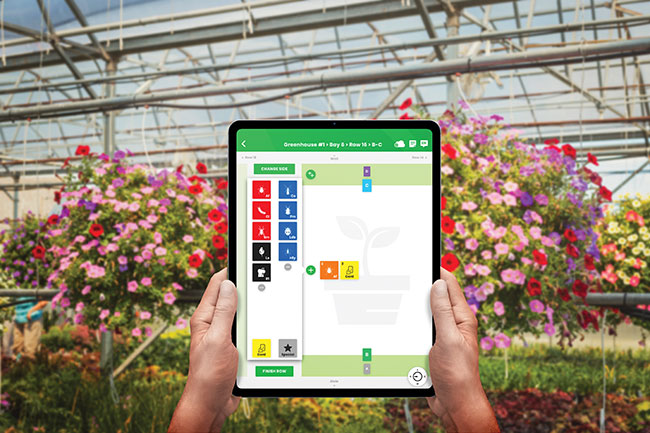 Scouting apps are improving in sophistication and capabilities. They can replace binders full of data and even generate insights to help greenhouses make decisions. Pictured: IPM Scoutek’s dashboard.
Scouting apps are improving in sophistication and capabilities. They can replace binders full of data and even generate insights to help greenhouses make decisions. Pictured: IPM Scoutek’s dashboard. The battle against greenhouse pests has meant a mountain of paper records that would put any librarian to the test.
Enter 21st century technology and digital apps. While it may be difficult for some to part with binders containing decades of valuable information, the shift to digital tracking is inevitable and much more efficient, effective and usable.
“Don’t leave your data on a page,” says Cara McCreary, greenhouse vegetable IPM specialist for the Ontario Ministry of Agriculture, Food and Rural Affairs (OMAFRA). “There is so much you can learn from it. Not just in the moment, but throughout the production cycle and from year to year.”
Many of these apps aim to minimize the tedious parts of scouting, offering pre-populated pest records and customizable templates for faster recordkeeping. But that’s not all. Electronic records allow growers to more easily identify areas prone to higher pest pressure, whether during specific times of the year or triggered in part by particular weather events.
By gaining insight into pest occurrence and growth, timing of biological control applications and efficacy of biocontrol agents and pesticides, use of these apps can help reduce costs while increasing the efficacy of management techniques. The results can lessen the need for pesticides and increase crop health and yield.
When evaluating apps, McCreary suggests looking for key features that may fit a greenhouse’s needs. “Is it easy and quick to enter data? How would the speed compare to writing something on paper?” she asks. Other areas to look for include additional language options or graphics to overcome language barriers, customizability of the app, and options to generate targeted reports.
IPM managers, owners, scouts, growers – each person is looking for different pieces of information at a different level of detail, says McCreary. Can the app generate a detailed report, as well as a brief overview?
With rapid improvements in app capabilities over the past few years, the next step is to maximize the possibilities offered by artificial intelligence.
“The more we get used to digitizing and sharing data, the better these apps will be at predicting and making accurate management recommendations,” says McCreary.
Here’s a look at some notable and emerging apps being used by Canadian greenhouses to combat pest problems.
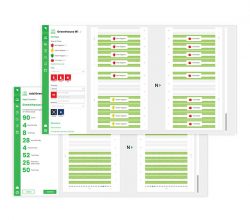
IPM Scoutek focuses on creating software that growers will want to use. Image: IPM Scoutek
IPM Scoutek
In collaboration with leading greenhouse growers, technology innovators Brian Hendel and Carrie Izsak created IPM Scoutek, a scouting app and management interface that produces comprehensive pest and disease insights.
“This software improves the speed and accuracy of scouting, pest management and the traceability and cost of sprays and biologicals,” says Izsak, co-founder and CEO IPM Scoutek, based in Windsor, Ont.
Suitable for all greenhouse sectors, the app enables growers to more easily and accurately record pest and disease pressures. Growers can instantly identify risks to their crop using live pest pressure maps, then take action. The software also helps track the movement and density of biological control agents and measures their impact.
To make sense of the data, advanced reporting generates reports showing scouting efficiency, pest trends, and comparative analyses in costs and efficacy. A greenhouse mapping function allows for highly detailed and flexible crop configurations.
For seamless communication, customizable scouting and crop protection assignments can be instantly updated and shared. User-specific access is available, from scouts to owners. Pest, disease and product libraries can also be tailored, and label searches linked to Health Canada.
“While most software companies build software that check functional boxes, we create software that people want to use, from its well-architected interface, to its visual appeal, to the relentless struggle for fewer clicks and less user work,” says Izsak.
Focusing on the software as the main product rather than an add-on service, the team actively troubleshoots with clients and incorporates feedback from greenhouse owners and growers in building new features. “The result is a very low friction, low barrier-to-adoption solution.”
Available in English and Spanish, plans are in place to roll out other languages commonly used in the greenhouse.
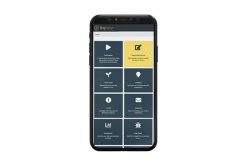
BugVision’s quick start process has users up and running in under a half hour. Screenshot: BugVision, PHONE: zlatko_plamenov / Freepik
BugVision
First released in July 2019 by Ipsum Vision Inc., the BugVision app helps decipher data collected into digital records, collating information from the old-school method of pen and paper as well as the newer format of Excel scouting sheets.
“Our pest management strategy is based on planning rather than action triggered by scouting numbers,” says Sébastien Leroux, owner of Ipsum Vision and developer of BugVision. Scouting and monitoring thresholds are set to check that the strategy is working. “And when required, a curative plan is triggered to get pest infestations under control.”
The grower starts by selecting from pre-populated lists of pests, bugs, traps and plants, then creating and mapping locations in the software to reflect the greenhouse layout.
From this, says Leroux, growers can prepare templates for regular monitoring and data input, then finetune their needs from there. This is all part of the quick start procedure that helps users get up and running in less than half-an-hour.
“You can set up thresholds for each crop/pest pair and be notified,” says Leroux. The dashboards highlight two major pieces of scouting information, namely the trends of the different pests and locations of their hotspots. Customizable reports and charts are presented here, which include filters that allow the operator to drill down for a finer analysis and to help make decisions.
For specific crops and situations, such as crop stages, environment, and time of year, Leroux says that his team at BugVision works alongside greenhouse operators to implement a preventive plan that will keep pests under control.
BugVision’s data is available remotely and access is customizable to four different levels, with varying degrees of permission.
“You can invite your favourite consultants to participate and provide you with remote advice,” says Leroux.
Version 2.0 is being prepared for launch during the first quarter of 2021, and is set to include features that will lighten data input tasks. Language-wise, French and Spanish are in the works.
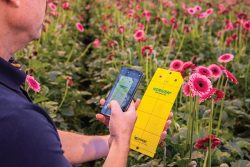
Natutec Scout identifies and counts thrips and whiteflies on Horiver cards. Photo credit: Koppert Biological systems
Natutec Scout
Koppert Biological Systems replaced their previous software with the Natutec Scout app, which received the GreenTech Innovation Award in 2019. It has two parts: a mobile app and a dashboard.
The app offers customizable templates to start. Once the user selects the crop, scouting options for pests and diseases appear, and the data is all linked to location. What’s impressive is the app’s ability for image recognition, which currently identifies and counts thrips and whiteflies using photos taken of Horiver sticky cards.
The dashboard then uses this data for oversight of pests and diseases. Capable of creating detailed maps, reports and comparisons for specific locations in the greenhouse, information can be whittled down to the post level in real-time.
“It is wonderful to now have an app on your cell phone that has all the maps for your farm at your fingertips to input all your findings at their exact location within each range,” says Shannon Impens, Koppert’s scouting supervisor. “One is no longer left to guess where the pests, hotspots or diseases were located, or where to place the biologicals. It’s now all right there on the screen for us to see.”
The user can also add treatments and download reports analyzing the efficacy of biological and chemical applications.
“Now we can click a button and compare data week-to-week, month-to-month, year-by-year, etc. and it’s so much easier and more convenient,” says Impens.
With the dashboard accessible remotely, a grower or a consultant can immediately see the uploaded maps from each scouting session from wherever they are. A monitoring function emits alerts when pests have reached or exceeded harmful thresholds. This allows the chance to make quick decisions on what is needed to rectify issues in problem areas.
“Natutec Scout offers extensive analysis, graphs, alerts, providing optimal timing for starting biological solutions resulting in a healthier crop,” says Impens. “Centrally stored data is accessible from anywhere you are remotely and fully customizable to use with not only vegetable crops, but also in ornamentals and cannabis crops.”
A help button in the app connects the user with a Natutec Scout Program Manager. The app is currently available in seven languages: English, Italian, French, Spanish, Russian, Dutch and Polish.
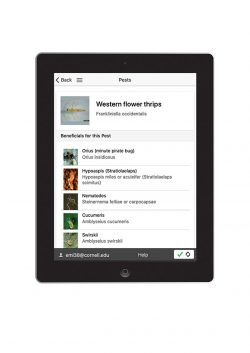
Pocket IPM Greenhouse Scout offers cross-linked pages on insect pests and beneficials. Screenshots from: E. Lamb, TABLET: FREEPIK
Pocket IPM Greenhouse Scout
Cornell University’s Pocket IPM Greenhouse Scout is a mobile app that combines pest and biological control information with an interactive system for collecting scouting and application data.
The app covers the primary insect pests of greenhouse floriculture crops – including aphids, fungus gnats, shore flies, thrips, whiteflies, mites, scales and mealybugs, and leafminers – and the beneficial insects used to manage them. Though not customizable per se, the pre-populated library is designed to be flexible in expanding to a broader range of crops, including vegetables or cannabis. Developers can add new insect pests on request.
As a reference guide, the app provides information on identification of insect pests and beneficials, which are cross-linked for easier reference. Pest pages include damage caused, life cycles, and how to monitor for the pest along with pictures. Pages on beneficials include information on best environments, methods for using the organism, how to check for viability, and interactions between pesticides and the biocontrol agent. Growers should double check with the PMRA before using any listed crop protection products, as not all will be registered in Canada.
As a scouting tool, users create ‘locations’ where they would like to scout – be it a sticky card, a crop or a bench – and choose insects and beneficials to include in their counts for that location. The app creates a QR code for each location, which can be printed and used to mark the location or crop. Using a smart device, the QR code leads to a scouting page with the selected insects and date already loaded.
A user can also add information on applications of biological control agents and pesticides used to manage pests, linked to location by the same QR code.
“Scouting and application data is recorded and graphed by location and date so that the grower can see the effect of pest management actions,” says Dr. Elizabeth Lamb, of the NYS Integrated Pest Management Program, Cornell University. “From the website, graphs or raw data can be viewed directly or downloaded, if they really want to keep those three-ring binders!”
For technical support, both Lamb and the programming company are on hand to address them. Efforts are underway to acquire funding for translating the app into Spanish, with the potential for other languages in the future.
Print this page